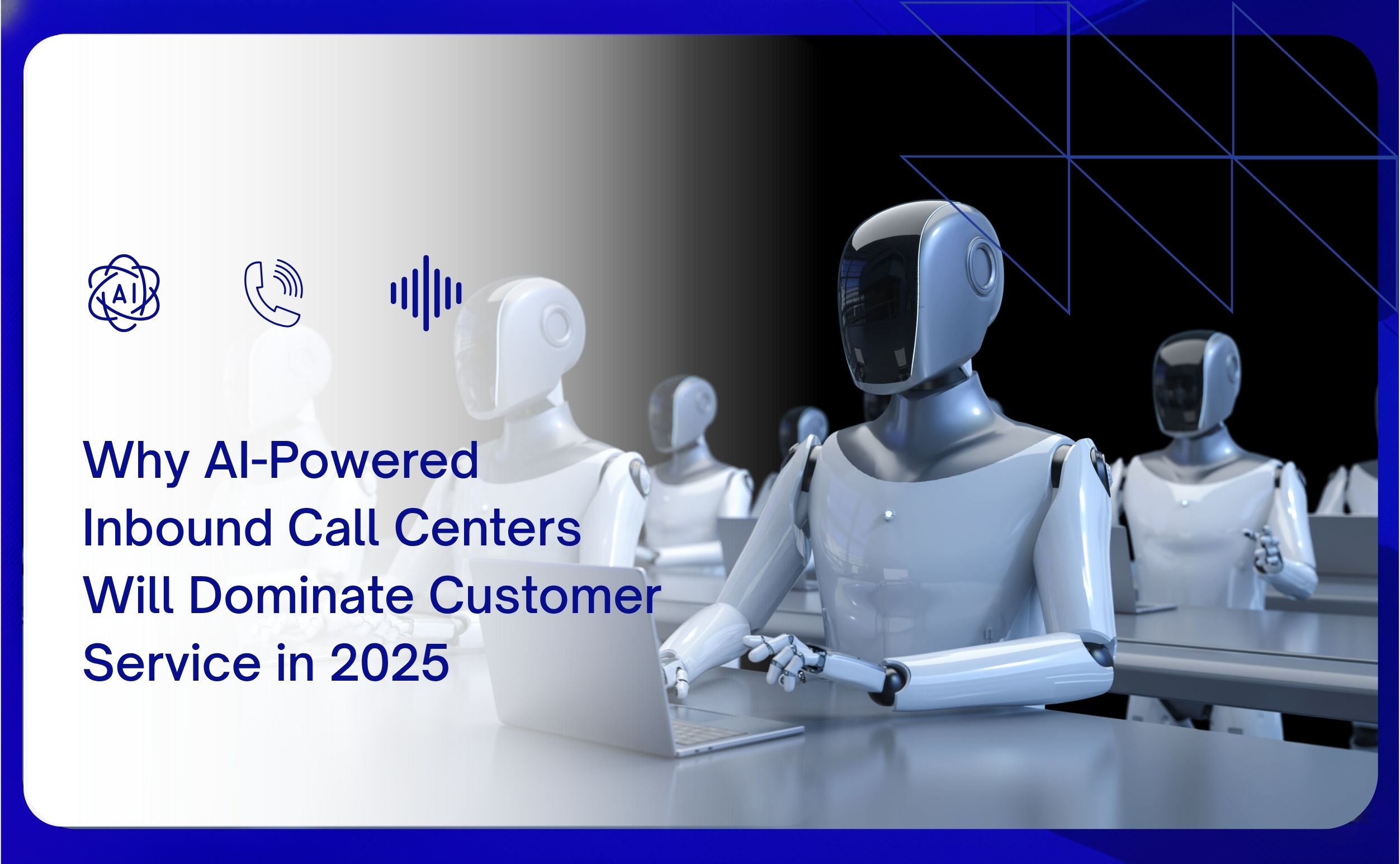An AI inbound call center uses artificial intelligence to manage customer calls. It applies intelligent call routing to connect customers with the right agent and handles routine tasks with minimal human support. Through it, most businesses have lowered their operational costs and achieved higher customer satisfaction.
Do you know what even a single missed moment of support can cost you? The current sale + a lot of new customers that a dissatisfied person could have brought. Studies show that only 13 out of 100 consumers will recommend a company if they think its service is “very poor.”
The worst part? Research shows that 91% of unhappy callers never return! Thus, as a solution, many D2C companies and consumer brands operating in regions like the US, UK, and Australia are setting up an AI inbound call center. Instead of long waits and repeated explanations, AI studies customer history, supports automation, and even assists agents in delivering the best answers instantly.
But are businesses really using AI in customer support departments? Read this article to check out five reasons why AI inbound call centers are set to dominate customer service in 2025.
Is an AI Inbound Call Center Popular in 2025? Check What The Current Numbers Show!

AI inbound call centers are becoming the new standard in 2025! IBM research found that about 80% of routine inquiries are now handled instantly by virtual agents and chatbots. Several D2C companies and consumer brands earning $5M+ revenue are turning to AI because it:
- Supports automation
- Cuts costs
- Shortens wait times
- Improves customer satisfaction
Want to believe it? Want to see some latest numbers? Below are some statistics picked from recent studies/ research:
| Impact Area | What AI Delivers | Numbers That Prove It |
| Customer Wait Times | An AI inbound call center reduces waiting time through callback queues and smart routing. |
|
| Call Handling Time | Voice AI systems offer instant answers to basic and routine queries. |
|
| Intelligent Call Routing | Intelligent call routing matches customers with the right agent on the first attempt. | Up to 20% reduction in handling times due to smart routing. |
| First-Contact Resolution | Due to precise customer-agent matching, most customer issues are resolved on the first call itself. | FCR rates improved by up to 75%. |
| Cost Savings | Support automation lowers staffing and operational overhead. | 30 to 40% reduction in support costs. |
5 Reasons AI Inbound Call Centers Will Dominate Customer Service in 2025!

AI customer engagement is at an all-time high! According to Gartner, 80% of customer service organizations now use generative AI to improve productivity and customer experience (CX). Are you still in the remaining 20%? Don’t let your competitors gain an edge!
In 2025, you can start using a mix of human agents + AI inbound call center to offer your customers the best CX. To better your knowledge, below are five reasons why most D2C brands nowadays use an AI inbound call center in their customer service departments:
1. AI Can Analyze Past Customer Data
An AI inbound call center has the power to understand each customer before the conversation even begins. It pulls data related to each of your customers:
- Past purchases
- Service history
- Previous preferences
So now, when a customer calls, your human agent already sees a clear profile:
- What they bought
- What issues did they face before
- What offers might interest them
The benefit? Your agents can give better suggestions, such as recommending a discount on a product the customer buys often. Please note that traditional call centre systems can’t do this because they don’t connect data in real time.
2. AI Can Make Every Interaction Personal in Real Time
Do you think AI just prepares the data before a call? Nope! It works during the conversation, too. Let’s see how:
| AI Inbound Call Center Supports Automation | AI Inbound Call Center Gives Live Suggestions |
|
|
Did you know? An AI inbound call center uses customer data to give answers as per each person’s needs. Studies show that such a personalized approach improves customer satisfaction by up to 15%.
3. AI Can Reduce Customer Efforts with Proactive Support
Traditional call centers react only when someone calls with a problem! Now, an AI inbound call center flips this model. It can offer “proactive customer support” by performing predictive analytics. By doing so, it can identify issues early + send alerts or solutions before customers even reach out.
For example,
- Say there’s a known service disruption.
- Now, AI can notify customers in advance.
- This reduces call volume and shows that your business values its customers.
Furthermore, support automation also lowers customer effort as an AI inbound call center can also offer multiple self-service options. Let’s check them out:
| Self-Service Options Offered by AI Inbound Call Center | Explanation |
| Self-Service Portals |
|
| Interactive Voice Response (IVR) |
|
| Knowledge Base Access |
|
4. AI Can Schedule Your Agents As Per Real-Time Demand
One of the biggest challenges in the customer support department is balancing staff with customer demand. Let’s see how it impacts businesses:
| Case I: Too Few Agents During Peak Times | Case II: Too Many Agents During Quiet Hours |
| It leads to long customer wait times and frustration. | It leads to wastage of money as you are paying for idle staff. |
Now, an AI inbound call center solves this mismatch by analyzing call patterns and predicting busy times in advance. For example,
- During holidays or sales, AI can schedule more agents so no customer is left waiting.
- When call traffic is low, it reduces overstaffing and diverts agents to other operations.
Additionally, another benefit is allowing agents to choose schedules that fit their needs. Such flexibility leads to happier agents, who are less likely to quit. This lowers attrition rates and saves hiring costs.
5. AI Can Offer Omnichannel Support that Puts Customers First
Offer support where your customers are! Realize that modern customers no longer stick to one channel.
- They may start with a chatbot.
- Switch to email
- And finally, they call to finish the conversation.
Won’t your team be bamboozled? Yes, without the right tools, both your customers and agents will end up repeating themselves, which creates frustration.
Now, an AI inbound call center with “omnichannel orchestration” abilities solves this problem. It tracks customer interactions across platforms. Your agents always have the full history in front of them, no matter where the conversation started. Also, your customers are saved from repeatedly narrating their issues and case facts.
According to Gartner, omnichannel systems increase customer happiness by 25% and lower costs by 35%.
Want the Best Mix of Human + AI Agents? Outsource Your Customer Support to Atidiv in 2025!
In 2025, AI inbound call centers are offering “hyper-personalized interactions”. They are using real-time data to:
- Greet customers by name
- Suggest relevant solutions
- Recall preferences
When combined with 24/7 omnichannel messaging solutions (across phone, chat, email, and social media), there is are high chances AI inbound call centers will dominate most of 2025 and beyond!
But relying 100% on AI is not the right approach! The best results come from a hybrid model where AI handles repetitive tasks and humans solve complex problems. If you need support in building such a model, Atidiv is a trusted customer experience solutions provider with 15+ years of expertise.
Our organization serves 70+ clients worldwide and operates in 20+ industries. We use the latest artificial intelligence technologies to boost CX. Recently, Atidiv saved $1.3M for a U.S. tire retailer and $500K annually for a UK firm by managing over 230,000 support tickets.
Additionally, our past clients have achieved cost savings up to 60% as compared to running in-house teams. Book a free consultation to learn how we help businesses!
AI Inbound Call Center FAQs
1. Can I replace my human agents with AI in 2025?
Ideally, you should not! That’s because currently the scope of an AI inbound call center is limited to:
- Basic support automation in which it handles routine questions
- Intelligent call routing and agent scheduling
- Real-time agent assistance
For personal, serious, and high-stakes issues, you will still need your team of human agents who can resolve issues with creative thinking and empathy. Thus, the best approach in 2025 is “hybrid”, where you try to benefit from AI-human collaboration.
2. Is AI inbound call center technology too costly for small businesses?
Nowadays, several AI software are cloud-based and are available on subscription models. Thus, you are only required to pay for what you use. To save more, initially, you can even opt for their beginner or basic plans as they are less costly (in some cases, even free!).
Furthermore, if you analyse the cost-benefit from a long-term view, the savings from lower wait times, less staff requirements, and higher customer satisfaction often outweigh the AI software subscription cost.
3. How does AI hyper-personalize every interaction?
AI uses past data to personalize every interaction! Most AI inbound call centers:
- Remember preferences
- Predicts needs
- Greet customers by name
Next, they try to minimize hold times by offering instant solutions. This reduces frustration and makes customers feel valued. The positive impact? Your business starts earning repeat business.
4. What metrics should I track to see AI’s impact?
Some major metrics you can observe are:
- Average wait time
- First-call resolution (FCR)
- Customer satisfaction score (CSAT)
- Call abandonment rate
Generally, an AI inbound call center improves these metrics via intelligent call routing, support automation, and offering multiple self-service options.
5. How quickly can I see results after adopting AI?
You can expect to see improvements within 1 to 2 months of implementing AI in your call center. Once AI starts routing intelligently or answering routine questions, early wins often happen in metrics like:
- Average handle time (AHT)
- Customer satisfaction (CSAT)
- Wait times
However, for more substantial results (such as cost savings, return on investment (ROI), and higher first-contact resolution), it usually takes 3 to 6 months.

